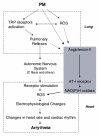Cardiac oxidative stress and dysfunction by fine concentrated ambient particles (CAPs) are mediated by angiotensin-II
- PMID: 20718632
- PMCID: PMC3771644
- DOI: 10.3109/08958378.2010.503322
Cardiac oxidative stress and dysfunction by fine concentrated ambient particles (CAPs) are mediated by angiotensin-II
Abstract
Inhalation exposure to fine concentrated ambient particles (CAPs) increases cardiac oxidants by mechanisms involving modulation of the sympathovagal tone on the heart. Angiotensin-II is a potent vasoconstrictor and a sympatho-excitatory peptide involved in the regulation of blood pressure. We hypothesized that increases in angiotensin-II after fine particulate matter (PM) exposure could be involved in the development of cardiac oxidative stress. Adult rats were treated with an angiotensin-converting enzyme (ACE) inhibitor (benazepril), or an angiotensin receptor blocker (ARB; valsartan) before exposure to fine PM aerosols or filtered air. Exposures were carried out for 5 hours in the chamber of the Harvard fine particle concentrator (fine PM mass concentration: 440 +/- 80 microg/m(3)). At the end of the exposure the animals were tested for in situ chemiluminescence (CL) of the heart, thiobarbituric acid reactive substances (TBARS) and for plasma levels of angiotensin-II. Also, continuous electrocardiogram (ECG) measurements were collected on a subgroup of exposed animals. PM exposure was associated with statistically significant increases in plasma angiotensin concentrations. Pre-treatment with the ACE inhibitor effectively lowered angiotensin concentration, whereas ARB treatment led to increases in angiotensin above the PM-only level. PM exposure also led to significant increases in heart oxidative stress (CL, TBARS), and a shortening of the T-end to T-peak interval on the ECG that were prevented by treatment with both the ACE inhibitor and ARB. These results show that ambient fine particles can increase plasma levels of angiotensin-II and suggest a role of the renin-angiotensin system in the development of particle-related acute cardiac events.
Figures






Similar articles
-
Cardiac oxidative stress and electrophysiological changes in rats exposed to concentrated ambient particles are mediated by TRP-dependent pulmonary reflexes.Toxicol Sci. 2008 Apr;102(2):328-36. doi: 10.1093/toxsci/kfn005. Epub 2008 Jan 9. Toxicol Sci. 2008. PMID: 18184637
-
PM-induced cardiac oxidative stress and dysfunction are mediated by autonomic stimulation.Biochim Biophys Acta. 2005 Oct 10;1725(3):305-13. doi: 10.1016/j.bbagen.2005.05.025. Epub 2005 Jun 20. Biochim Biophys Acta. 2005. PMID: 16005153
-
Ozone co-exposure modifies cardiac responses to fine and ultrafine ambient particulate matter in mice: concordance of electrocardiogram and mechanical responses.Part Fibre Toxicol. 2014 Oct 16;11:54. doi: 10.1186/s12989-014-0054-4. Part Fibre Toxicol. 2014. PMID: 25318591 Free PMC article.
-
Health effects of concentrated ambient air particulate matter (CAPs) and its components.Crit Rev Toxicol. 2009;39(10):865-913. doi: 10.3109/10408440903300080. Crit Rev Toxicol. 2009. PMID: 19863385 Review.
-
Enhancing cardiac protection after myocardial infarction: rationale for newer clinical trials of angiotensin receptor blockers.Am Heart J. 2000 Jan;139(1 Pt 2):S23-8. doi: 10.1067/mhj.2000.102904. Am Heart J. 2000. PMID: 10618584 Review.
Cited by
-
Pulmonary diesel particulate increases susceptibility to myocardial ischemia/reperfusion injury via activation of sensory TRPV1 and β1 adrenoreceptors.Part Fibre Toxicol. 2014 Feb 25;11:12. doi: 10.1186/1743-8977-11-12. Part Fibre Toxicol. 2014. PMID: 24568236 Free PMC article.
-
Oxidative Stress and Cardiovascular Risk: Obesity, Diabetes, Smoking, and Pollution: Part 3 of a 3-Part Series.J Am Coll Cardiol. 2017 Jul 11;70(2):230-251. doi: 10.1016/j.jacc.2017.05.043. J Am Coll Cardiol. 2017. PMID: 28683970 Free PMC article. Review.
-
Peat smoke inhalation alters blood pressure, baroreflex sensitivity, and cardiac arrhythmia risk in rats.J Toxicol Environ Health A. 2020 Dec 16;83(23-24):748-763. doi: 10.1080/15287394.2020.1826375. Epub 2020 Oct 5. J Toxicol Environ Health A. 2020. PMID: 33016233 Free PMC article.
-
The mechanisms of air pollution and particulate matter in cardiovascular diseases.Heart Fail Rev. 2017 May;22(3):337-347. doi: 10.1007/s10741-017-9606-7. Heart Fail Rev. 2017. PMID: 28303426 Review.
-
Hypertension and Age-Related Cognitive Impairment: Common Risk Factors and a Role for Precision Aging.Curr Hypertens Rep. 2020 Sep 3;22(10):80. doi: 10.1007/s11906-020-01090-w. Curr Hypertens Rep. 2020. PMID: 32880739 Free PMC article. Review.
References
-
- Antzelevitch C. Transmural dispersion of repolarization and the T wave. Cardiovasc Res. 2001;50:426–431. - PubMed
-
- Barker TA, Massett MP, Korshunov VA, Mohan AM, Kennedy AJ, BC. B. Angiotensin II type 2 receptor expression after vascular injury: differing effects of angiotensin-converting enzyme inhibition and angiotensin receptor blockade. Hypertension. 2006;5:942–9. - PubMed
-
- Berl T. Angiotensin-converting enzyme inhibitors versus AT1 receptor antagonist in cardiovascular and renal protection: the case for AT1 receptor antagonist. J Am Soc Nephrol. 2004;15(Suppl 1):S71–6. - PubMed
-
- Brook R, Brook JR, Urch B, Vincent R, Rajagopalan S, Silverman F. Inhalation of fine particulate air pollution and ozone causes acute arterial vasoconstriction in healthy adults. Circulation. 2002;105:1534–6. - PubMed
Publication types
MeSH terms
Substances
Grants and funding
LinkOut - more resources
Full Text Sources
Miscellaneous
